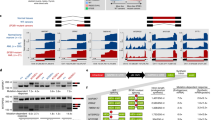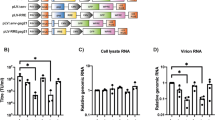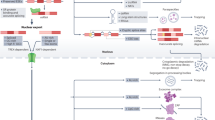Abstract
It is now widely accepted that the primary transcripts of many eukaryotic genes contain intervening sequences (introns)1–3. These introns, which vary considerably in length, have been found in both coding and noncoding regions4–15. They are removed from the primary transcript in one or more steps by a process called RNA splicing16. The role of RNA splicing, the size and position of introns and the signals which modulate the splicing process are under intense investigation. These studies have been greatly facilitated by the use of viral mutants or viral–eukaryotic recombinant molecules. The SV40 system has been of particular value in elucidating certain genetic elements which are critically involved in the splicing process17–21. Further insight into the biological significance of the splicing process has come from a mutant from which precisely one intron has been removed (intron-minus mutant, dl-2350). This deletion mutant has the potential to circumvent the need for splicing. However, the inability of dl-2350 to accumulate late viral transcripts indicates that splicing is a requirement for the biogenesis of stable mRNA22. This finding is supported by studies using the mouse βmaj globin gene inserted into SV40. The inserted portions contained either the complete globin gene23 or a segment encompassing the intron plus the entire 3′ end of the gene24. As polyadenylation is known to precede splicing2,3, the possibility exists that every transcript possesses sequences near the 3′ end that are directly involved in the splicing process. We report here that, to test this possibility as well as to pursue the question of whether the splicing event and/or defined sequences in the intron are required for the biogenesis of mRNAs, we inserted an isolated intron lacking its own genomic 5′ and 3′ ends into the intron-minus mutant previously described. The experimental protocol provided for obtaining both possible orientations of the insert relative to the late genomic region. Investigation of the transcriptional products indicated that stable mRNA was produced only by the mutant containing the intron in the sense orientation.
This is a preview of subscription content, access via your institution
Access options
Subscribe to this journal
Receive 51 print issues and online access
$199.00 per year
only $3.90 per issue
Buy this article
- Purchase on Springer Link
- Instant access to full article PDF
Prices may be subject to local taxes which are calculated during checkout
Similar content being viewed by others
References
Tilghman, S. M., Curtis, P. J., Tiemeier, D. C., Leder, P. & Weissmann, C. Proc. natn Acad. Sci U.S.A. 75, 1309–1313 (1978).
Lai, C. J., Dhar, R. & Khoury, G. Cell 14, 971–982 (1978).
Blanchard, J. M., Weber, J., Jelinek, W. & Darnell, J. E. Proc. natn. Acad. Sci. U.S A. 75, 5344–5348 (1978).
Lindenmaier, W. et al. Proc. natn. Acad. Sci. U.S.A. 76, 6196–6200 (1979).
Cordell, B. et al. Cell 18, 533–543 (1979).
Dugaiczyk, A. et al. Proc. natn. Acad. Sci. U.S.A. 76, 2253–2257 (1979).
Lomedico, P. et al. Cell 18, 545–558 (1979).
Busslinger, P., Portman, R. & Birnstiel, M. Nucleic Acids Res. 6, 2997–3008 (1979).
Cochet, M. et al. Nature 282, 567–574 (1979).
Van Ooyen, A., Vanden Berg, J., Mantei, N. & Weissmann, C. Science 206, 337–344 (1979).
Gannon, F. et al. Nature 278, 428–434 (1979).
Lai, E. C. et al. Cell 18, 829–842 (1979).
Tiemeier, D. C. et al. Cell 14, 237–245 (1978).
Leder, A. et al. Proc. natn. Acad. Sci. U.S.A. 75, 6185–6191 (1978).
Tilghman, S. et al. Proc. natn. Acad. Sci. U.S.A. 74, 4406–4410 (1977).
Berger, S. M., Moore, C. & Sharp, P. C. Proc. natn. Acad. Sci. U.S.A. 74, 3171–3175 (1977).
Lai, C.-J. & Khoury, G. Proc. natn. Acad. Sci. U.S.A. 76, 71–75 (1979).
Khoury, G., Gruss, P., Dhar, R. & Lai, C. J. Cell 18, 85–92 (1979).
Breathnach, R., Benoist, C., O'Hare, K., Gannon, F. & Chambon, D. Proc. natn. Acad. Sci. U.S.A. 75, 4853–5847 (1978).
Seif, L., Khoury, G. & Dhar, R. Nucleic Acids Res. 6, 3387–3398 (1979).
Benoist, C., O'Hare, K., Breathnach, R. & Chambon, P. Nucleic Acids Res. 8, 127–142 (1980).
Gruss, P., Lai, C.-J., Dhar, R. & Khoury, G. Proc. natn. Acad. Sci. U.S.A. 76, 4317–4321 (1979).
Hamer, D. H. & Leder, P. Cell 18, 1299–1302 (1979).
Hamer, D. H. & Leder, P. Nature 281, 35–40 (1979).
Konkel, D. A., Tilghman, S. M. & Leder, P. Cell 15, 1125–1132 (1978).
Ghosh, P. K. et al. J. biol. Chem. 253, 3643–3647 (1978).
Maniatis, T. et al. Cell, 15, 687–701 (1978).
McCutchon, J. H. & Pagano, J. S. J. natn. Cancer Inst. 41, 351–357 (1968).
Lai, C. -J. & Nathans, D. Virology 60, 466–475 (1974).
Tegtmeyer, P. & Ozer, H. L. J. Virol. 8, 516–524 (1971).
Southern, E. M. J. molec. Biol. 98, 503–517 (1975).
Reddy, V. B. et al. Science 200, 494–502 (1978).
Fiers, W. et al. Nature 273, 113–120 (1978).
Alwine, J. C., Kemp, D. J. & Stark, G. R. Proc. natn. Acad. Sci. U.S.A. 74, 5350–5354 (1977).
Murray, V. & Holliday, R. FEBS Lett. 106, 5–7 (1979).
Lerner, M. R., Boyle, J. A., Mount, S. M., Wolin, S. L. & Steitz, J. A. Nature 283, 220–224 (1980).
Kozak, M. Cell, 15, 1109–1123 (1978).
Brockman, W. W. & Nathans, D. Proc. natn. Acad. Sci. U.S.A. 71, 942–946 (1974).
Penman, S. J. molec. Biol. 17, 117–130 (1966).
Schaffner, W., Kunz Daetwyler, H., Telford, J., Smith, H. O. & Birnstiel, M. L. Cell 14, 655–671 (1978).
Aleström, P., Akusjärvi, G., Perricaudet, M., Mathews, M. B., Klessign, D. F. & Pettersson, U. Cell 19, 671–681 (1980).
Author information
Authors and Affiliations
Rights and permissions
About this article
Cite this article
Gruss, P., Khoury, G. Rescue of a splicing defective mutant by insertion of an heterologous intron. Nature 286, 634–637 (1980). https://doi.org/10.1038/286634a0
Received:
Accepted:
Issue Date:
DOI: https://doi.org/10.1038/286634a0
This article is cited by
-
The intron of Arabidopsis thaliana polyubiquitin genes is conserved in location and is a quantitative determinant of chimeric gene expression
Plant Molecular Biology (1993)
-
Characterization of a cell line derived from zebrafish (brachydanio rerio) embryos
In Vitro Cellular & Developmental Biology - Animal (1993)
-
Unusual splice sites revealed by mutagenic inactivation of an authentic splice site of the rabbit β-globin gene
Nature (1983)
-
SV40 recombinant molecules express the gene encoding p21 transforming protein of Harvey murine sarcoma virus
Nature (1981)
Comments
By submitting a comment you agree to abide by our Terms and Community Guidelines. If you find something abusive or that does not comply with our terms or guidelines please flag it as inappropriate.



